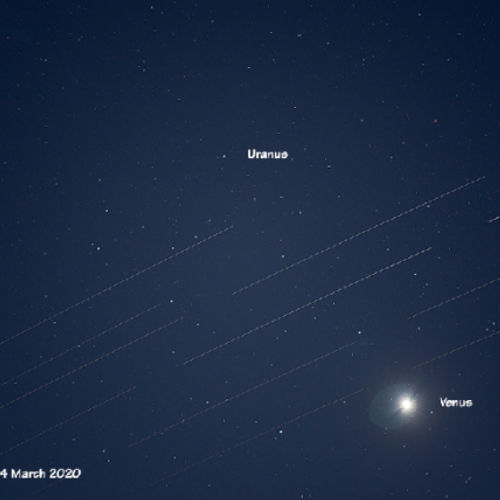| ID | #1588661997 |
| Added | Tue, 05/05/2020 |
| Author | July N. |
| Sources | |
| Phenomena | |
| Status | Investigation
|
Initial data
May 5, 2020 in the sky of the Netherlands, many witnesses noticed a group of consistently moving the same distance from each other objects.
For example, an eyewitness from the city of Nijmegen provides the following information:
20 bulbs in a row. The first 4 have the same distance from each other. A few minutes later again 16. Also with the same distance and in one line. Looking at the photos, we were really impressed with the Pictures were taken with Xiaomi Note Pro 10.
* Objects were seen when looking at the photo.
According to ufomeldpunt.nl a satellite Starlink.
Translated by «Yandex.Translator»
Original news
NIJMEGEN, GD — 20 lichtbollen achter elkaar aan. Eerst 4 met dezelfde afstand van elkaar. Een paar minuten later nog eens 16. Ook met dezelfde afstand en in 1 lijn achter elkaar aan. Na het bekijken van de foto's waren we echt verbaasd over de vormen. De foto's zijn genomen met een Xiaomi Note 10 Pro.
* Het object werd opgemerkt bij het terugkijken van de foto's.
Starlink satellieten
Hypotheses
Objects in motion, captured on a long exposure

Most often this artifact is called skayfish if the lens gets a passing bird or insect. It is based on the discrepancy between the speed of the video and the frequency of the flapping of insect wings. Essentially, each video drops a few strokes of the wings of an insect, which when viewed looks like "arrow", provided with long protuberances. The motion of the insect by its translucent body seems to "boom" and vibration of the wings give the appearance of bumps.
Satellite

Ordinary satellites, which often look like single, not very bright luminous dots moving smoothly in the night sky, are quite often mistaken for UFOs. After the Starlink satellites (near-Earth satellite systems developed by SpaceX, in order to create a cheap and high-performance satellite Internet communication channel and technical transmitters for receiving and transmitting signals from earth and orbit) were launched, it became possible to observe groups of satellites (up to 60 pieces) flying one after another.
Events
Rocket launches (from space.skyrocket.de)
- Site: Wenchang Space Launch Center (WSLC), Hainan (China) Vehicle: CZ-5B Payload: XZF-SC RCS-FC-SC
Investigation
Data from the site findstarlink.com locations for NETHERLANDS - Nijmegen:
Timings with poor visibility
12:02 am, 5 May 2020
Starlink-3, DIM (2.9) for 6 mins
Look from WEST to NORTHEAST (details)
Elevation (from horizon): start: 10° max: 75°, end: 67°11:02 pm, 5 May 2020
Starlink-3, DIM (2.4) for 6 mins
Look from WEST to EAST (details)
Elevation (from horizon): start: 10° max: 85°, end: 11°
The description really looks like this group of satellites, but the time of observation is not the same (although the witness could be mistaken in the indication of time or specify approx.) According to the pictures to tell nechego impossible, since the objects on it are blurred due to the movement of the operator's hands.
Translated by «Yandex.Translator»
News: As satellites Starlink spoil astronomy

David Blanchard of Flagstaff city in the U.S. state of Arizona decided to capture the connection of Venus and Uranus in Aries March 4, but with the planets at the sudden got "star-bombing".
"During the exposure half a dozen Internet Starlink satellites flew between planets. At least one satellite broke and for a short time became one of the brightest objects in the sky brighter than it was only the Moon, Venus and, maybe, Sirius," said the photographer.
News: Satellites Starlink — increasing threat to observational astronomy

April 19, Amateur astronomer from the Czech Republic Zdenek Bardon made the two orthogonal direct from satellites Starlink in a single frame. According to Bardon, he tried to take a picture of a disintegrating comet Atlas (C2019 Y4). At the same time, he noted that the night sky in his location suffers from light pollution, and to create an image of the comet required an overlay of multiple exposures.
When he was taking pictures, it did not consider the trajectory of the satellites Starlink, and many of the photographs were ruined.
Resume
Similar facts
Log in or register to post comments


